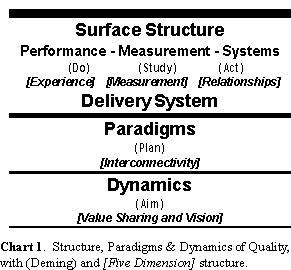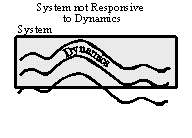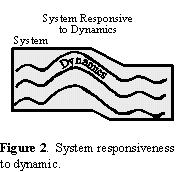Quality-Based Strategic Planning:
Strategic Capability Building
by Richard E. Winder
Copyright 1994, Richard E. Winder. All Rights Reserved,
Two of the most powerful tools of business are strategic planning and total quality
management. Until recently these tools have been viewed as separate organizational
functions. At the recent 48th Annual Quality Congress of the American Society for Quality
Control the following question was addressed: What if we link quality with strategic
planning, so that quality becomes a central focus of the organization rather than a
separate function?
 The linking of
these two tools provides a synergistic combination that is far more powerful than either
of them separately. Strategic planning brings to quality the aim, or vision, that Dr.
Deming said must be part of every system.(1) Quality brings
to strategic planning the flexible responsiveness that is necessary to respond to the
voice of the customer in today's fast-changing markets.
The linking of
these two tools provides a synergistic combination that is far more powerful than either
of them separately. Strategic planning brings to quality the aim, or vision, that Dr.
Deming said must be part of every system.(1) Quality brings
to strategic planning the flexible responsiveness that is necessary to respond to the
voice of the customer in today's fast-changing markets.
In the quality context the total system of an organization can be viewed as a surface
structure or delivery system which is built on underlying paradigms and which responds to
underlying dynamics.(2) The delivery system itself consists
of performance (based on competencies), measurement, and relationships or systems, all of
which address a particular need or set of needs. It is the linking of the organization's
competencies with the needs of customers which provides the organization's vision, or
reason for being. It is the organization's vision that is the foundation for strategic
planning. Unfortunately, the focus of many organizations is on the delivery system rather
than the vision of the organization. Some become so involved in fine tuning the delivery
system that they actually lose touch with customer dynamics.
 What if the delivery
system of the organization is not responding to the underlying customer dynamics? Then
there will be unmet customer needs, and the aim of quality--to build and sustain
relationships--will not be realized, as customers seek other organizations which will
fulfill those needs.
What if the delivery
system of the organization is not responding to the underlying customer dynamics? Then
there will be unmet customer needs, and the aim of quality--to build and sustain
relationships--will not be realized, as customers seek other organizations which will
fulfill those needs.
One company, an auto body repair shop, modified its delivery system to respond to the
dynamic that women are the key decision makers in 70% of new car purchases (and, the owner
postulated, in the majority of car repairs). By simply modifying its system to respond to
these dynamics (washing the car after repair; providing a clean, neat waiting room;
providing a woman facilitator), the company's sales tripled in one year: from $525,000 in
1985 to $1.6 million in 1986.(3)
 This is the essence of
modern strategic planning: constantly designing and re-structuring the delivery system to
respond to the dynamics. Since dynamics are now (more than ever before) in a constant
state of change, traditional concepts of strategic planning are no longer valid. It is no
longer possible or wise to develop and rely on precise projections of future activity,
because in a fast state of change, unforeseen events will undoubtedly have an impact on
those projections. What is important in today's markets is not the ability to precisely
plan the future, but rather the development of skills and capabilities
("competencies") which permit the organization to flexibly recognize and respond
to changes in the dynamics. Tom Peters calls this "Strategic Capability
Building."(4)
This is the essence of
modern strategic planning: constantly designing and re-structuring the delivery system to
respond to the dynamics. Since dynamics are now (more than ever before) in a constant
state of change, traditional concepts of strategic planning are no longer valid. It is no
longer possible or wise to develop and rely on precise projections of future activity,
because in a fast state of change, unforeseen events will undoubtedly have an impact on
those projections. What is important in today's markets is not the ability to precisely
plan the future, but rather the development of skills and capabilities
("competencies") which permit the organization to flexibly recognize and respond
to changes in the dynamics. Tom Peters calls this "Strategic Capability
Building."(4)
Quality-Based Strategic Planning, then, focuses on 1) Measuring and understanding the
dynamics of the environment in which the organization desires to operate, 2) Understanding
and developing the experience base (the skills and capabilities, or competencies)
necessary to flexibly recognize and respond to those dynamics, and 3) Constantly modifying
the system to actually respond to (rather than simply react to) the dynamics. In
Quality-Based Strategic Planning, the role of future projections has shifted from
providing a future snapshot of the organization to providing a means of measuring a shift
in dynamics (by comparing what would have been expected under current dynamics with what
actually happens).(5)
The implications of Quality-Based Strategic Planning on education and training are
profound. While it is possible to develop the required "experience base"
necessary to understand and respond to the dynamics the old fashioned way--through trial
and error--many organizations do not have the premium of time. If they take the time to
build their experience base through trial and error, they may find themselves out of
business, as competitors become more responsive to customer needs. Education and training
can provide the background and "practice" necessary to build the competencies
and capabilities more quickly and more comprehensively by drawing on the experience of
others who have already been through the trial and error.
1. Deming, W. Edwards, The New Economics, Cambridge, Mass.:
Massachusetts Institute for Technology, Center for Advanced Engineering Study, 1993.
2. This structure is based on a five dimension quality structure of
experience, measurement, relationships and systems, interconnectivity and paradigm logic,
and value sharing. See Winder, Richard E., "Fulfilling Quality's Five
Dimensions," 47th Annual Quality Congress Transactions, May 24- 26, 1993.
3. Conlin, Elizabeth, "Collision Course," Inc.,
December, 1992, pages 132-142.
4. Peters, Thomas, Thriving on Chaos, (New York:
HarperPerennial, 1991), page 477.
5. It is this prediction/measurement function which is the
"Theory of Knowledge" component of Dr. Deming's Theory of Profound Knowledge.
Deming, Edwards W., The New Economics.
 The linking of
these two tools provides a synergistic combination that is far more powerful than either
of them separately. Strategic planning brings to quality the aim, or vision, that Dr.
Deming said must be part of every system.(1) Quality brings
to strategic planning the flexible responsiveness that is necessary to respond to the
voice of the customer in today's fast-changing markets.
The linking of
these two tools provides a synergistic combination that is far more powerful than either
of them separately. Strategic planning brings to quality the aim, or vision, that Dr.
Deming said must be part of every system.(1) Quality brings
to strategic planning the flexible responsiveness that is necessary to respond to the
voice of the customer in today's fast-changing markets.  What if the delivery
system of the organization is not responding to the underlying customer dynamics? Then
there will be unmet customer needs, and the aim of quality--to build and sustain
relationships--will not be realized, as customers seek other organizations which will
fulfill those needs.
What if the delivery
system of the organization is not responding to the underlying customer dynamics? Then
there will be unmet customer needs, and the aim of quality--to build and sustain
relationships--will not be realized, as customers seek other organizations which will
fulfill those needs. This is the essence of
modern strategic planning: constantly designing and re-structuring the delivery system to
respond to the dynamics. Since dynamics are now (more than ever before) in a constant
state of change, traditional concepts of strategic planning are no longer valid. It is no
longer possible or wise to develop and rely on precise projections of future activity,
because in a fast state of change, unforeseen events will undoubtedly have an impact on
those projections. What is important in today's markets is not the ability to precisely
plan the future, but rather the development of skills and capabilities
("competencies") which permit the organization to flexibly recognize and respond
to changes in the dynamics. Tom Peters calls this "Strategic Capability
Building."
This is the essence of
modern strategic planning: constantly designing and re-structuring the delivery system to
respond to the dynamics. Since dynamics are now (more than ever before) in a constant
state of change, traditional concepts of strategic planning are no longer valid. It is no
longer possible or wise to develop and rely on precise projections of future activity,
because in a fast state of change, unforeseen events will undoubtedly have an impact on
those projections. What is important in today's markets is not the ability to precisely
plan the future, but rather the development of skills and capabilities
("competencies") which permit the organization to flexibly recognize and respond
to changes in the dynamics. Tom Peters calls this "Strategic Capability
Building."